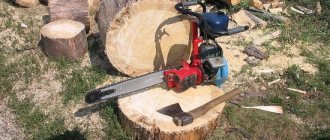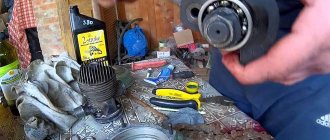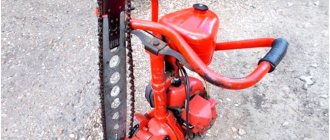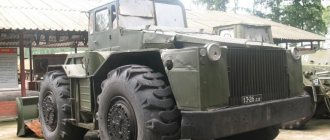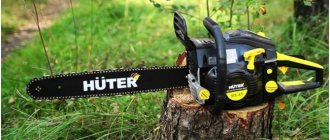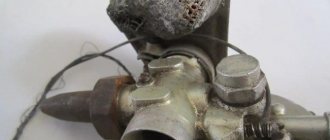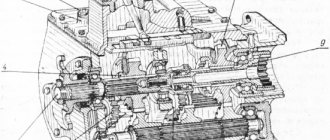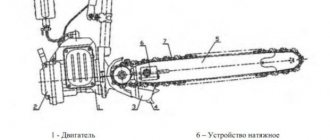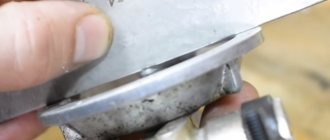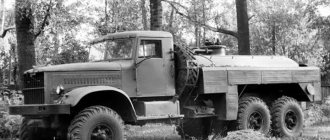The first model of the Druzhba chainsaw was developed in 1953 and released in 1955. They were produced at machine-building plants in the cities of Biysk and Perm. All models of these chainsaws have a two-stroke, single-cylinder, air-cooled engine with a carburetor. Thanks to its convenient design and high performance, Druzhba is still in demand, and saws of the first models are also in working condition. The main purpose of the Druzhba chainsaw is felling forests and sawing logs.
Before operating any chainsaw, be sure to read the manufacturer’s instructions and follow all safety rules.
No "friendship"!
There is an opinion that the first domestic chainsaw appeared in the 50s, and it was the legendary “Friendship”, around the birth of which a huge number of fables have been piled up. In fact, domestic chainsaws appeared two decades before “Friendship” and managed not only to fight in the Finnish and Great Patriotic Wars, but even... to receive an Oscar.
Wehrmacht chainsaws
During the war, several manufacturers of motor saws were located in Germany itself and in the territories under its control, so the Germans had no problems with the choice. The most famous, perhaps, are two models - the Dolmar CL and the Stihl KS43, which was a more powerful version of the Stihl BDKH and Stihl BDK models of the mid-1930s.
Dolmar CL chainsaw, model 1939. Engine capacity 241 cm3, power 8 hp, weight 45 kg. The Stihl KS43 chainsaw of the 1943 model was similar in power, but due to the use of light alloys it turned out to be much lighter: engine capacity 247 cm3, power 8.5 hp, weight 36 kg
The Dolmar CL model chainsaw could be seen in the old exhibition of the Minsk Museum of the Great Patriotic War, in the exhibition with a partisan camp
Of course, these are not the only models of chainsaws available to the German army during the Second World War, but they are usually referred to in cases where they want to compare “theirs and ours.” “In our country,” as a rule, they show hand saws and draw conclusions about the disparate technical equipment of the armies of Germany and the USSR. But are these conclusions true?
Chainsaws of the Red Army
Due to the peculiarities of the Soviet economy, one cannot expect a large number of Soviet brands of chainsaws (at that time they said not “model”, but “brand”). In fact, the USSR met 1941 with one MP-220 chainsaw. The MP-300 saw, developed in the early 30s, is already outdated, and the new MP-180 appeared later.
Chainsaw MP-220, model 1935 (an improved model MP-220A was produced in 1941). Engine capacity 220 cm3 (effective 187 cm3), power 3.5 hp, weight 32 kg
At different times, this model was produced by a motorcycle plant in Izhevsk and the Perm Machine-Building Plant, now named after Dzerzhinsky - as we see, ZiD began producing chainsaws 20 years before the appearance of “Druzhba”!
Unfortunately, wartime sources do not spoil us with specific models of Soviet chainsaws. In textbooks and standards of military engineers, reports, statistics and even factory archives, they most often wrote simply “motor saw” or “chain saw” - no brand, no power, no weight. But there are two numbers that can be used reliably:
Still from the documentary “The Defeat of German Troops near Moscow”
“Note from the NGOs of the USSR and the General Staff of the Red Army to the Politburo of the Central Committee of the All-Union Communist Party (Bolsheviks) I.V. Stalin and the Council of People's Commissars of the USSR V.M. Molotov outlining the scheme for the mobilization deployment of the Red Army” reports that on January 1, 1941, the Red Army had 3,908 motor saws. And in the book “Engineering Troops of the Soviet Army 1918-1945” in the table “production of engineering weapons during the Great Patriotic War” there is a line “motor saws” indicating their number - 3598 pieces.
In total, we have approximately 7,500 motor saws of our own production, which passed through the army during the war. There may be some questions about this number, but it gives the general picture - the number of domestically produced motor saws was measured in thousands of pieces.
The Oscar-winning chainsaw
So, what are we talking about? We are talking about the 1942 Soviet film “The Defeat of German Troops near Moscow” and its American version “Moscow Strikes Back”, which received an Oscar in the 1943 category “Best Documentary Film”. At the beginning of the film (in the Soviet version at the end of the 10th minute) there is a scene of creating a forest blockage using a chain saw.
Documentary film “The defeat of German troops near Moscow.” Required episode from 09:59 timing
Based on the characteristic all-rotating design, the direction of the exhaust, the shape of the tank and the impeller casing, it can be clearly established that this is an MP-220 chain saw. There is unexpected evidence that during the Great Patriotic War, domestic chainsaws not only existed, but also “received” the Oscar film award - although not individually, but as part of a team.
How to set the ignition on a Ural chainsaw?
Signs that the ignition system needs to be adjusted include loud chainsaw sounds hitting the carburetor or muffler. In this case, the fuel does not have time to completely burn in the internal combustion engine cylinder, which gradually makes starting more difficult and increases the consumption of fuel consumed.
The adjustment procedure looks like this:
- First you need to remove the plastic cover of the saw's protective housing and inspect the space underneath it. If necessary, the parts of the instrument should be carefully cleaned with a hard brush;
- Next you need to find the flywheel position adjustment screws. By turning them counterclockwise one by one, the operator will be able to move the element away from the standard magneto;
- Then you need to attach the template used to the ignition coil;
- After this, you need to turn the screws one by one in a clockwise direction. Once the engine's built-in flywheel is closely aligned with the previously set template, the operator can release the adjustment screws.
At the end, you will need to install the housing cover and monitor the operation of the tuned saw.
[edit] Gallery
| 1 | 3 | yes | Show | Hide |
|
Historical development of the first chainsaw
The key elements that later went into the design of the very first chainsaw (Walter S. Shape's chain saw, tire, carburetor internal combustion engine) were invented at the end of the 19th century.
The progenitor of the modern chainsaw appeared relatively recently - at the beginning of the 20th century. In 1926, the famous German mechanical engineer and owner of a mechanical engineering company for the production of washing machines and steam boilers, Andreas Stihl, issued a patent for a mechanical chain saw equipped with an electric motor.
The patented chain saw weighed almost half a hundredweight and was operated by two physically strong operator workers. With all the powerful work of engineering, by 1929 it was possible to reduce its considerable weight by only a couple of kilograms. Shtil began to look for other ways to increase the power of the tool while reducing its weight and, as an experiment, decided to replace the electric motor with a gasoline one. In the same year, the inventor presented a test copy of a mechanical chain saw with an internal combustion engine with a power of 6 hp. and weighing 46 kg, it was the very first chainsaw in the world. This innovative direction became fundamental for the further evolution of the chainsaw - Shtihl filed a patent for the saw chain and tires he created, introduced into his own production a centrifugal clutch and a pressure oil lubrication system for chains.
In 1943, Stihl, commissioned by the Wehrmacht, produced the KS-43 two-handed chainsaw for military-strategic purposes. Particularly light, made of magnesium alloy, the air blower housing, fuel tank and float carburetor reduced the total weight to 36 kg.
In 1947, lumberjack and founder Joseph Buford Cox modernized the saw chain by developing a new C-shape of steel teeth.
As before, the heavy weight of the tool limited the demand for it among ordinary consumers, and until the end of the forties the saw remained in demand only as a professional tool for lumberjacks and builders. The ultra-light saw, released in 1950 by STIHL, weighing only 16 kilograms, produced the effect of a bomb exploding, and further improvements in the design made it possible in 1954 to introduce an even lighter 11-kilogram model with a two-stroke internal combustion engine onto the gardening tool market. And, from that moment on, the chainsaw became firmly entrenched in the household arsenal of home craftsmen.
1959 was the year of the creation of the gearless STIHL Contra, which became a legend among the first chainsaws with a diaphragm carburetor that allowed rotation of the saw in all spatial planes. The insignificant weight of 12.2 kg compared to previous models made it possible for the first time to be operated by one operator, increasing logging productivity significantly. Thus began the era of compact chainsaws.
In the 60s, chainsaws continued to improve: an anti-vibration system and an electronic ignition unit were developed, Husqvarna proposed the “two-mass” principle with the engine separated from the handle.
Developments of the 70s were aimed at creating the most comfortable conditions for those working with a chainsaw: a heated handle, a QuickStop brake for instantly stopping the chain, an automatic brake activated by inertial force, a single-lever control system, and a gas locking lever appeared.
In the mid-80s, a side chain tensioner, an Ematic chain lubrication system, an environmentally friendly BioPlus adhesive chain oil, and a catalyst for two-stroke engines were developed.
In the 90s, competition between STIHL and Husqvarna produced several landmark patents: tool-free chain tensioning and the centrifugal Air Injection air purification system.
Modifications
During the entire production of the chainsaw, Friendship 4 has not undergone any major design changes. Let's see what minor changes have occurred in the design of the chainsaw:
- 1950 - 1960 . The first structural modification concerned a change in the mounting option for the handles; they began to be attached to the fan cover, and subsequently the fastening was moved to the clamp that connected the engine and gearbox.
- 1960 - 1980 . At this time, a modification of the chainsaw called Druzhba - 4A, which had two main advantages: a contact magneto and the well-known KMP-100 carburetor, entered the assembly line and was produced for 20 years. At the end of the 80s, the modification of the Druzhba -4A chainsaw was discontinued.
- Late 1980s. Release of the Druzhba-4M Electron modification. Electronic ignition was used for the first time.
- 1990s . Equipping the chainsaw with a modern (at that time) carburetor KMP-100U. Changes in the saw set - the use of modern type chains.
Many people are confused and say that a number of other changes were made to the Druzhba 4 chainsaw, such as a removable starter, a detachable crankcase and a removable cylinder, but they are deeply mistaken. All these changes were made on the Ural chainsaw, the basis of which was Druzhba.
Chainsaw Taiga 245 – model description
This model of the Taiga brand differs from the vast majority of its market analogues in its increased weight. The main reason for this is heavy metal components, which have increased endurance and resistance to mechanical stress. Otherwise, this chainsaw is practically in no way inferior to models from other manufacturers, and in some aspects it even beats them.
The factory configuration of this petrol tool is based on a 2-stroke petrol engine, designed to increase the efficiency of the saw when working with hard wood. With a cylinder working volume of 75 cm 3 and a maximum crankshaft rotation speed of 7000 rpm, the tool is capable of sawing large dry branches and felling old forest trees with a trunk thickness of up to 45 cm. The special layout of the power unit allows the saw to quickly cut off sticky rotten branches without blocking the cutting set and increasing the volume of fuel consumed.
The parameters of the Taiga chainsaw in the 245th factory modification include:
- engine power – 3 l. With.;
- fuel/oil tank – 600/260 ml;
- bar length/chain pitch – 45 cm/0.325″;
- weight with headset and filled tanks – 5.35 kg.
This gas-powered tool is equipped with a reinforced metal crankcase, which reliably protects the lower part of the engine from moisture seepage, sawdust and mechanical damage.
Chainsaw Ural BP 3800 – parameters of the popular model
This Ural brand gas powered tool is equipped with all the necessary options to ensure stable operation of the model under high loads. The factory equipment of the popular branded saw includes a reliable gas engine, a high-precision lubrication system for cutting parts, an effective modified anti-vibration damping system for continuous vibration damping and a pre-reinforced mechanical inertial mechanized brake.
Options:
- power – 5.16 l. With.;
- branded tire length – 45 cm;
- factory chain pitch – 0.325″;
- weight including headset – 6.45 kg.
The saw is equipped with an intelligent forced fuel injection system, which ensures continuous fuel supply for stable operation of the tool in any operating conditions.
Types of saws
According to the nature of movement, saws are distinguished:
- hacksaw
- a long narrow blade makes reciprocating movements - round (disc)
- a disk with an outer cutting edge rotating on a shaft. - belt
- in the form of a closed flexible tape stretched between two rotating pulleys. - chain saw
- a saw, the working part of which is a chain closed in a ring and moving along a guide bar.
| Circular saw of mobile sawmill | Saw teeth close up | Coarse saw teeth close up | Setting tool (tool for setting saw teeth) |
Hand saws come in two-handed and one-handed varieties.
According to the design of the instrument, they are distinguished:
- bow
- a thin fabric is stretched between two holders - hacksaw
- the blade itself has sufficient strength and elasticity to hold its shape.
| Two-handed saw | Hacksaw |
Saws are classified according to their purpose (what they cut):
for wood - the most common type of saw, characterized by a variety of teeth, handles, and structure.
Teeth size: height 1–18 mm, width at the base 1.5–12 mm. Large teeth cut wood more efficiently, but leave a rough cut; medium ones - they cut more slowly, but their cut is cleaner; small - they cut wood cleanly, but very slowly. Sharpening teeth: pulse sharpening - they become dull the fastest, but can be re-sharpened; hardened tooth - remains sharp longer, but cannot be sharpened again, 3D sharpening - very sharp, allows you to cut towards and away from you.
- for metal
- this saw is usually called a hacksaw. It has a relatively narrow replaceable blade stretched between the ends of a U-shaped metal bracket. With small teeth relative to other saws (height 1-1.5 mm, width 1.2-2 mm) - for cellular concrete
- this saw usually has a Teflon coating and carbide tips on every second tooth. - for drywall
- this saw has a pointed steel blade. - for stone
, etc. Usually these are various types of electric saws. Often, several types of diamond saws are used to cut stone, mounting them in a machine, the design of which depends on the size of the stones being cut and the purpose of sawing the stone. A diamond saw is a thin disc with small diamonds on the edge. It is not the disc itself that cuts, but the smallest invisible diamond particles located along the edge of the disc.
Saw materials (what they are made of):
- brass
- mainly for slapping on top of a non-working surface and for connecting to a handle; - iron
- in the cheapest saws; this material has been replaced by steel; - zinc or copper
- only for cutting salt crystals in the kitchen; - steel
is the most widely used material due to its low cost, ease of processing, and strength; - diamond
- due to its maximum hardness, it is used for cutting hard materials such as stone, concrete, asphalt, brick, ceramics, glass, semiconductors, precious stones; - high speed steel
- for cutting steel, copper, aluminum and other metals. Cobalt alloys are used for cutting steel. - tungsten carbide
- also used for cutting hard materials; Compared to high-speed steel, it is an even harder, but less flexible material.
What to do with spare parts
You won’t find spare parts for the Druzhba 4 chainsaw in stores; after all, it’s already a rarity. The only place where you can still buy them is at a flea market - a market where grandparents sell what they have lying around at home. Believe it or not, you can find many spare parts there in new condition. They lay there for a long time, but were never put on the saw.
Another place is bulletin boards, like Avito. They especially often sell chains and tires for Druzhba chainsaws.
The Druzhba 4 chainsaw is as simple as a Kalashnikov assault rifle, thanks to this it is durable (especially models from the 50s and 60s), easy to maintain and repair. The saw can be easily repaired in the field “on the knee” without special tools. On your farm, it will be useful for harvesting timber or firewood in small quantities. For professional work, it is still better to use modern saws. Everything said in the article is confirmed by numerous reviews from Internet users.
During the operation of the Ural chainsaw, various malfunctions in the operation of the carburetor occur, due to the use of mostly low-quality fuel or violation of operating rules. And in order to try to restore functionality, you need to know the structure of the carburetor of the Ural chainsaw.
Photo-1. Schematic diagram of the carburetor of the Ural-KMP-100U chainsaw.
The carburetor consists of:
1-inlet valve, enrichment button -2, suction valve-3, carburetor membrane-4,
idle screw-5, full throttle screw-6, locking spring-7, starting air damper-8,
main system nozzle-9, diffuser-10, throttle lever-11, carburetor body-12,
throttle valve-13, idle gas system nozzles-14 and 15, idle gas fuel system channel-16,
check valve-17, return spring-18, valve seat-19, valve lever-20, fuel cavity of the regulator-21,
pump membrane-22, housing-23, pump cover-24, booster pump cavity-25. Designation by arrows on the circuit diagram:
1-fuel supply, 2-communication with the atmosphere, 3-air flow, 4-pressure from the crankcase.
〉 Operating principle of the KMP-100U carburetor
The operating principle of the KMP-100U carburetor is as follows:
From the gas tank, fuel is supplied through the fuel line and channel -1, indicated by a red arrow (see schematic diagram) through valve-3, into cavity 25. After that, using inlet valve-1, fuel is supplied to the fuel valve seat 19. Until the chainsaw engine starts , fuel does not enter the cavity of the pressure regulator -21 since the seat hole -19 is blocked by lever -20.
[edit] Scope and device
Nya! The first chain saws appeared at the beginning of the nineteenth century and were originally intended for sawing human bones for medical purposes, including during difficult childbirths. Today, this type of saw is still part of dentists' torture arsenal.
Their younger brothers, which appeared almost a century later, are now used mainly for logging, construction and other work. It is also often traditionally used to dismember flesh (and delivers so much that it can suddenly become a potent antidepressant), in some cases also by doctors. It is powered by an internal combustion engine or an electric motor (then it is already an electric saw, but these are nuances).
Varieties
FUUUUUUUUUUUUUUUUUUUUUUUCK
Circular chainsaw - the cutting tool is an abrasive or metal disk with teeth and/or diamond coating. IRL is mainly used for working on stone and concrete; with an abrasive disc it can cut metal. People often call it a “grinder” (especially the electric variety, although technically a “grinder” is an angle grinder) or a “petrol cutter.”
Chainsaw - cuts with a chain with teeth. The main purpose is to cut wood. Through the transmission system, the force from the engine is transmitted to the chain, which, rotating along the tire and sprocket, performs its main function - SAW! And finally, the most important thing - you can SAW A DOOR with a chainsaw, if the door is wooden, of course. Openings for doors and windows in a log house are cut really well. But a power chain saw is more suitable for this - unfortunately, it is more dangerous to use.
Power cutter - saws with a chain with teeth. Not much different from a chainsaw, in fact, a large chainsaw with diamond teeth (spray coating, the teeth themselves are made of especially high-strength types of metal. Designed for sawing stone, yes, stone, you can often see geologists using it to cut cobblestones for samples, this could be would be considered a good weapon because of its COLOSSAL power, but sooooo..... the dry weight of 12-15 kg quickly breaks the looming material for fap.
- Trimming (the best means for amputating limbs)
- The harsh Nordic Husqvarna can threaten you too, %username%!
- Well, very harsh. Threatens everyone. Without exception.
- Ural-2T. Let's support domestic producers!
- Friendship won!
Advantages and disadvantages
Positive qualities of Druzhba brand chainsaws:
- high productivity and the ability to work for a long time without interruptions for 50 minutes;
- simple design;
- the presence of high handles, thanks to which you can saw in a standing position, they also ensure safer use and reduce the level of vibration;
- accessible location of all parts;
- the chain is driven by high engine speeds and is stationary at idle;
- low octane fuel can be used;
- the presence of an emergency brake in most models;
- when the saw chain gets stuck, the saw does not stall;
- precise and even cutting;
- The service life, subject to operating rules and proper care, can range from 15 to 30 years.
Classification of saw bars
A saw set refers to the working elements of a chainsaw, which are intended for direct cutting: a chain and a bar.
One of the points that influence the choice of a particular model is the type of tire and its length. Saw bars for chainsaws are classified as follows:
narrow flat - works in tandem with a low-profile chain of a non-professional household chainsaw, minimizes the risk of injury due to the virtual absence of the “kickback” effect, which is especially important for chainsaw beginners; lightweight - made of two steel plates connected by a polyamide layer. This design significantly reduces the overall weight of the chainsaw itself, which can serve as a serious advantage when performing certain types of work; bar with replaceable head – installed on professional chainsaws of medium and high power, used for large volumes of long-term work
Tire type is a serious characteristic, but not the only one that needs to be taken into account when purchasing a chainsaw.
Spark plug setting
In order to ensure normal engine operation, the spark plug must have an adjusted electronic gap and be free of lubricant, slag and carbon deposits. This is done so that the spark passes through it normally and does not disappear, and, as a result, the engine does not stall during operation.
To adjust the spark plug, you must do the following:
- Tighten the fuel screw fully.
- Unscrew it 3 turns.
- Screw in the propeller and back it out two full turns.
Seal the transition coupling with any sealant or place a tin strip. Another reason for the lack of a spark may be dirt adhering to the spark plug, in which case you should simply clean it.
Echo chainsaws: review and technical characteristics of the best models
When deciding which chainsaw to choose for your dacha, you should pay attention to the products of the Japanese company Echo, which is a world-famous manufacturer of garden equipment and spare parts for it. The best advertisement for this product is its quality, which invariably pleases even the most demanding customers. ECHO chainsaws have proven themselves well among users, thanks to high-quality Japanese assembly and ease of use
ECHO chainsaws have proven themselves well among users, thanks to high-quality Japanese assembly and ease of use
Chainsaw Echo CS-353ES
One of the most popular chainsaws from this company is the CS-353ES model. Equipped with a two-stroke single-cylinder engine, this saw is able to cope with even the most serious tasks that are put before it. And although the power of this device is not great (only 1.59 kW/2.16 hp), the manufacturer claims that this is more than enough for home use.
Among other technical characteristics, it is worth noting the following:
- saw chain speed can reach 13500 rpm;
- fuel consumption is 0.74 kg/h;
- automatic supply of oil to the chain is provided, although the operator cannot regulate this process;
- a primer is available, as well as a manual starter equipped with an “Easy Start” system;
- body weight without tires, oil and gasoline is 4 kg;
- A muffler is provided to suppress noise.
In addition to high productivity, developers require a high level of safety from their products, as evidenced by the presence of a protective shield between the chain and the handle. If you touch it, the chainsaw automatically turns off. In addition, a protective shield is provided on the back of the case, in case any equipment breaks down.
Chainsaw model Echo CS-353ES
It is very convenient to care for the Echo CS-353ES chainsaw, since the manufacturer has provided an easy-to-open lid over the air filter. So all you need to do if it gets clogged is open the lid and clean it. Moreover, you can easily adjust or replace the chain: for this purpose, a special screw is provided in the side of the case.
The basic kit of the Echo CS-353ES chainsaw includes a bar, a saw chain, a cover to protect the bar, instructions for use and self-repair, as well as some tools (two keys of different shapes and a small screwdriver).
One of the main advantages of the Echo chainsaw is the high level of operator protection when working with the device
Chainsaw Echo CS-350WES
Echo CS-350WES is a more powerful device that can practically be classified as a semi-professional device, because in addition to preparing firewood, it can be used for sawing building materials. Thoughtful weight distribution allows the operator to work comfortably without overloading the muscles.
The chainsaw is equipped with a two-stroke engine with a displacement of 35.8 cm? and air cooling function. Moreover, its power is 1.48 kW, and the chain rotation speed can reach 13,500 rpm.
For a comfortable and quick start, the chainsaw is equipped with CDI electronic ignition and an “Easy Start” system with a timer. In addition, there is a special handle on the body, designed to start the saw with a cold engine, which is responsible for adjusting the air-fuel mixture supply valve to the carburetor. Oil supply to the chain is carried out automatically with the ability to regulate its intensity. If you use a chainsaw at maximum power, the fuel consumption will be 1.12 l/h.
The advantage of the Echo CS-350WES chainsaw is the “Easy Start” function, thanks to which the recoil is almost invisible
Among the safety measures that have been applied to this chainsaw are:
- saw chain inertial brake;
- protective shield in front of the handle;
- blocker against accidental pressing of the gas trigger;
- chain catcher;
- rear handle guard;
- a special casing designed to protect the operator from burns as a result of touching the muffler.
The chainsaw kit includes a saw bar and a cover for it, as well as a small screwdriver, a pair of keys (10x19 mm) and an instruction manual.
Thanks to the heated carburetor, the Echo CS-350WES chainsaw can be used even in winter
Repair and modernization of Druzhba saws
Although these saws stopped being produced at the turn of the millennium, a huge number of them are still in use and sold on the Internet. Some are far from exhausting their resources. But even those that have lost their appearance and acquired problems in their work are easily restored.
After all, the body parts of these saws practically do not wear out, and the rest must be replaced. The video will help you avoid difficulties when disassembling “Friendship-4”:
Most often, during repairs it is necessary to change the crankshaft bearings, all seals and gaskets.
It will not be superfluous to replace the piston rings during disassembly. It is also possible to install a repair size for the piston group.
If your chainsaw has a gearbox without lubrication, then it is worth installing a more modern one. This will extend the life of the saw chain.
And here is a video of the device of such a gearbox, which shows how it differs from the standard one:
Such a new one from Ural costs about 3.5 thousand rubles, but with the cost of a slightly used Druzhba being 4 - 5 thousand rubles. this price may seem excessive. The same applies to other elements. So, if your contact ignition is working, then trade it for a new one or install an electronic one for 500 - 600 rubles. maybe it's not worth it. After all, the main problems with it arise due to damage to the crankshaft oil seal, and when replacing it, everything can return to normal.
A removable starter costs the same amount, so it’s better not to lose it. Some fasten it rigidly with self-tapping screws in a regular place and put up with certain inconveniences in work, and some fix it on a cable and find a place for it on the handle of the chainsaw.
It is cheaper to repair a carburetor using a repair kit.
The cost of a new one is about 1 thousand rubles.
The biggest modifications are most often made to the ignition system, namely: installing a car coil to replace the secondary winding of the standard coil. How to do this correctly is shown in the video:
At the same time, the spark becomes much more powerful, and problems with starting the saw are eliminated, especially in winter.
The chainsaw clutch practically does not fail, but sometimes requires minor repairs. It is designed in such a way that at low speeds the L-shaped profile does not unclench and the gearbox does not engage, but if the rivets on which it is attached become loose, then it can touch the outer part of the gearbox coupling at low speeds, then the clutch “drives.” It's worth trying to rivet them harder. And if the reason does not go away, then in this case buy a new clutch.
Chainsaw
| This section is missing references to information sources. Information must be verifiable, otherwise it may be questioned and deleted. You can |
The key structural elements of a chainsaw (chainsaw, bar, internal combustion engine) were created at the end of the 19th century. The practical use of the “saw set” has been going on since the beginning of the 20th century, while other types of drives were used: pneumatic, steam, mechanical, etc.
There is no reliable information about the first manufacturer of the chainsaw, and this right is disputed by several modern manufacturers. The most proven fact is that Andreas Stihl (Trademark Stihl) began producing gasoline-powered hand-held chainsaws in the late 1920s. At the very beginning of the 20th century, large chain sawmills were made that were driven by hand. All chain saws of that time, created for felling wood, were large, clumsy machines that were operated by at least two people. Many attempts have been made to create a powerful chain saw for cutting down trees. And finally, in 1926, German mechanical engineer Andreas Stihl created and patented the first hand-held chain saw with an electric motor. The instrument, Stihl, was named after him. In 1927, German entrepreneur Emil Lerp presented to the world his new development - Dolmar, model A. The instrument was equipped with a 245 cm3 engine with an output of 8 liters. With. and weighed 58 kg. It was the world's first gasoline-powered chainsaw. Dolmar is the name of the mountain in Thuringia where the first chainsaw test took place. Two years later, Andreas Stihl, continuing to develop tools for felling trees, released his chain saw with a gasoline engine.
Chainsaws in the USSR
The Soviet Union began purchasing foreign chainsaws (Rinco and Stihl) in the late 1920s. In 1935, the production of MP-220 chainsaws was mastered at the Perm plant named after Dzerzhinsky.
In the pre-war period, the war years and the first post-war period, chainsaws were not widely used in forestry, but this period played a positive role in the development of domestic chainsaws:
- specialists who developed domestic gas and electric saws in the 1930s, after the war created the K-5 electric saw and the Druzhba chainsaw
- experience has been accumulated in the development of mechanized felling technology
- sections on chain saws appeared in the curriculum
- a plant appeared, which since 1935 has been developing and serially producing chainsaws
The import of chainsaws from abroad and the start of their own production did not affect the nature of the Soviet economy; the bulk of logging in the USSR was done by prisoners in forced labor camps; the hard labor of prisoners in taiga logging did not undergo practically any mechanization. Until the mid-1950s, trees were felled with hand-held bow saws in extremely unfavorable weather and climatic conditions, usually waist-deep in snow or knee-deep in swamp slush, as this was required to fulfill production plans. In 1951-1952 “VAKOP” electric saws, weighing 12 kg each, began to be introduced, but forest fellers refused them and, to prove their rightness, they competed to see who could cut down a tree faster - with a “VAKOP” or a “beam”, and in most cases the winner was the latter, the “beam”. By 1954, the “beam” fell out of use, gradually being replaced by electric saws K-5, K-6, for which temporary power lines were laid across the workshop areas. Later, felling was carried out with Druzhba and Taiga chainsaws, which did not require power lines and were lighter.
Trouble-shooting
The design of the Druzhba 4 chainsaw is so simple that it allows you to easily repair many components yourself. The weakest point of the saw is considered to be the ignition and carburetor. There are even more problems with the contact ignition system. Let's figure out why these malfunctions occur and how to fix them yourself.
Carburetor adjustment
The first cause of problems with the carburetor is spark plugs filled with fuel mixture. This does not mean that you need to immediately disassemble the carburetor. First of all, pay attention to the gasoline valve; sometimes it is enough to bend it a little inward. This operation will reduce the amount of fuel supplied.
If this does not help, then move on to a simple carburetor setup operation:
- Tighten the fuel screw all the way.
- Unscrew it back 3 full turns.
- Tighten the propeller all the way.
- Loosen the propeller 2 full turns.
Don’t forget to check the seals for leaks to eliminate the possibility of air being sucked into the system; this can also cause a malfunction when the chainsaw starts and stalls.
How to set the ignition
People come to repair the ignition very often, especially if it is a contact one. The problem is expressed in the problem of starting a hot engine. This is due to a weak ignition system. You can’t just set it up, here you need to know the approach to how to adjust the ignition on the Druzhba 4 chainsaw, because... there are pitfalls.
We invite you to watch a video, the author of which talks in detail about adjusting the ignition of a chainsaw.
In principle, there is nothing complicated. To adjust the contactless, it is enough to connect the marks of the housing and the ignition unit. When adjusting the contact there are many nuances, the process itself is complex, so it’s worth watching the video above, the author talks in detail about the process. Here are the first adjustment steps:
- Set the piston to BDC.
- Clean the contact.
- Check the gap - 0.3mm.
- If the gap is smaller, then unscrew the fastening screw and increase the gap to 0.3 mm.
- Tighten the screw and check the clearance again.
- Set the ignition trigger so that it fires less than 4 mm before TDC (how to do this is described in detail in the video above).
Note, in order to avoid constant problems with contact ignition, it is being converted to contactless.
Basic faults
Rarely, but still other malfunctions occur with the saw. For example, there is no spark at the spark plug or the chainsaw does not start at all. For a better understanding and assimilation of information on troubleshooting such faults, we recommend watching the video.
Chainsaw rating: best models of 2022
Let's start the 2022 chainsaw rating with a description of the most popular brands in the household segment among Russian consumers.
Stihl MS 180
Although this model belongs to household modifications, it has many of the features of chainsaws of a higher class. It is one of the most purchased types of gas powered tools over the past few years.
Stihl is one of the leaders in the production of chainsaws; its products are distinguished by high quality, reliability, durability and functionality. The MS 180 model is characterized by minimal noise, low fuel consumption, easy starting and minimal vibration. Subject to compliance with operating regulations, this gasoline saw can serve properly for many years. The disadvantages of the model include difficulties in purchasing original spare parts, the lack of a primer and the high cost of components.
HUSQVARNA 236
The main feature of this model from a well-known Swedish company with a three-hundred-year history is its innovative motor technology, thanks to which the user can adjust the torque value at different shaft speeds.
This, in addition to increasing productivity, ensures minimal fuel consumption. The advantages of using the HUSQVARNA 236 chainsaw also include the availability of high-quality spare parts, while the disadvantages are increased noise at maximum load and the need to preheat the unit at idle for 2-3 minutes.
Carburetor settings
The carburetor in the Druzhba chainsaw is responsible for the fuel supply. And you need to be able to customize it for a specific type of work. There can be many reasons for incorrect carburetor settings: heavy load, increased vibration, poor quality of the fuel mixture, etc. Signals that the carburetor has been adjusted incorrectly are:
- Loss of power.
- The gasoline saw does not hold idle speed.
- Excessive fuel consumption.
- Production of smoke or excessive soot.
- Difficult to start or stalls during operation.
Adjusting the carburetor is very simple, the following sequence will help you figure it out:
- There are two screws on the chainsaw that are responsible for supplying fuel at minimum and maximum speeds, and the essence of the adjustment is to change their tension under different loads.
- Initially, you should adjust the supply of the fuel mixture at low speeds.
- Then adjust with another screw at maximum power.
- Adjust operation at idle speed.
- Double-check all modes again.
STIHL MS 880 review
By far the most powerful professional chainsaw, the STIHL MS 880 MAGNUM still has an excellent power-to-weight ratio for a large saw that is surprisingly nimble thanks to STIHL technology.
Ideal for felling and sawing large diameter trees, this saw is precisely balanced with excellent controllability and reliability. And with a staggering 23% increase in engine power. This is a model for professionals. For the most difficult tasks and extreme conditions. An incredible power-to-weight ratio and a new muffler are now available.
With lightweight clean HD2 filter and controlled flow oil pump. Ideal for frequent use when working with large wood. One of the most powerful chainsaws available on the market today. The decompression valve will easily ensure a quick start of the chainsaw. The fuel filler cap opens without tools for safe and easy refueling.
First of all, let's look at the engine of this monster. Here we can observe the first surprise: the engine power is 6.4 kW and the displacement is 121.6 cc. Of course, there are other giants of this type with even greater key figures, but usually these are only the weight of the models, not the engine numbers.
However, engines of this kind are not typical for the market. The heavy and powerful STIHL MS 880 Magnum petrol machine weighs 10.1 kg. In the case of this tool, we can observe an equal power to weight ratio, a very powerful engine with a heavy weight. Many other tools have higher weights and less powerful engines, such as the Remington RM5118R Rodeo. Compared to the Remington and many other tools, this model has an almost perfect power to weight ratio.
The next interesting thing is the variety of tire lengths available. The STIHL MS 880 chainsaw offers a truly very wide range of available tires from 17 to 59 inches. Only the STIHL MS 661 CM boasts a good bar range, but not as good a range as the STIHL MS 880. The variety of possible tasks is staggering. These “monsters” can deal with real giant trees within a few minutes. The fuel tank capacity is 1.3 liters, and this is not surprising. A powerful engine with a large displacement must have such a fuel tank. Operators may forget to add gasoline for several hours of operation. The next important indicator is the tank capacity - 0.7 liters.
Chainsaw MP-5 "Ural-2T Electron"
The unit called MP-5 “Ural-2T Electron” is a gas-powered saw for felling and bucking trees, as well as further processing of firewood.
Specifications:
- Chainsaw weight (without starter 200 g) – 10.3 kg;
- Dimensions L/W/H with tire – 880/455-460/460-560;
- Tire length - 46-55 cm;
- Width (groove, groove) – 5 mm;
- Power 3.68 kW or 5 hp;
- Maximum fuel consumption 632 g/kWh;
- Productivity – up to 100 cm of cut in 1 minute;
- Produced sound – 105 dB;
- Fuel tank 1.6 l;
- Refueling: A-72 gasoline and M-8B engine oil;
The supporting frame is equipped with a vibration damping device in the form of a hinged joint attached to the steering wheel, and the steering wheel itself is equipped with a vibration damping spring. Due to this, the operator's hands are protected from strong vibrations resulting from sawing.
